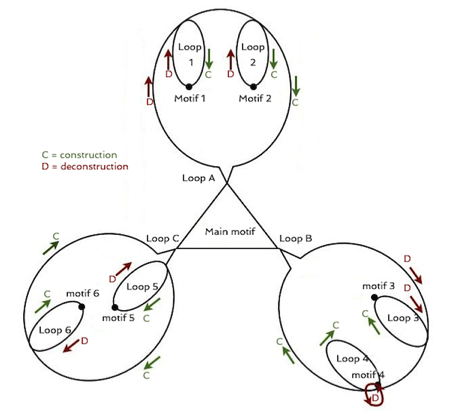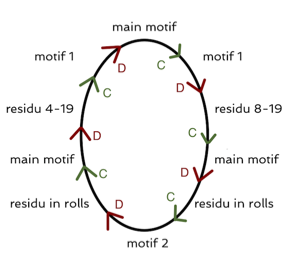Improving the practice and performance of contemporary music
The Loops-process
The loops-process defines a specific way in which musical parameters gradually transform during the repetition of one or multiple musical cells. A motif - or the residue of a previous motif - launches a succession of transformations acting on different musical parameters. These transformations are gradual and fragmented, thus always referring to the former motif within a constantly changing musical evolution. A succession of transformations creates a period. The quality of the period is dependent on the overall direction of the transformations. A loop contains a combination of periods that connect residues and motifs. The interactions between the loops define the structure of the overall composition.
A specific terminology is introduced for the analysis. By re-ordering the score in a vertical way, the different steps in the process are more visible. In every example a constructive element is marked in green, while a regressive element is marked in red. The different transformations and the division in periods and loops is a way to provide a structural framework for the composition. This framework is reflected in the clicktrack tool to support the practice of the score.
Transformations
Every transformation of a specific musical parameter holds two directions: constructive or regressive. The difference between constructive and regressive directions is clearly marked by opposites: a constructive transformation is building up a musical cell by the use of that specific parameter, while a regressive transformation is dismantling the cell by the use of this specific parameter. The table below shows an overview of the different musical parameters and their directions. Click on each parameter to find a more detailed description of the transformation.
melodydiminutionaddition
melodic curvecapricious / less definedfluent / more defined
rhythmaugmentation / density lowereddiminution / density raised
temporitardando / slowaccelerando / fast
dynamicsdiminuendocrescendo
rangedescendingascending
ambitussmallerlarger
phrasingmore staccatomore legato
Periods
A succession of transformations between two motives or between a residue and a motif is called a period. Frequently both transformational directions are present within a single period, each acting on different parameters. The predominant direction of the transformations within a period determines the quality of that period. If the transformations are mainly constructive, the period is also marked constructive. When the transformations are mainly regressive, the period is also marked regressive
Loops
A loop is the largest structural element in the composition. It contains a succession of a constructive period towards a motif and a regressive period that leads to the residue of the motif. Within the analysis a loop is marked with a number. Multiple loops can be combined into an overall Loop, which is marked with a letter.
Motif and residue
A motif is the center part of each loop. It acts as the ending point of a constructive period and thus is the most ‘completed’ form of the repeated cells within that loop: a motif has for example the most added components in the melody, the most fluent and defined melodic curve, the most dense rhythm and the fastest tempo. It will be high in range and contains a large ambitus at a loud(est) dynamic and legato phrasings. The motif is the starting point for a regressive period. During this period regressive transformations will dismantle the previously formed motif until a residue is left. This residue is opposite to the motif: it will often hold lesser elements in the melody, a wider rhythm, a less defined melodic curve, a smaller ambitus in a lower range and a (most) soft dynamic with more staccato phrasings. The residue acts as a starting point for a new constructive period and thus launches a new loop.
Structure
The loops process highly influences the overall structure of the composition. During the series of Loops-compositions, Philippe Hurel adds new elements to the transformations. This results in a new structural form in each composition. The introduction of a main motif - a motif acting as a corner stone for each large loop - is an important addition to the process. It creates new possibilities in musical evolution and inspires every subsequent addition. Continuous transformation and variation are more and more integrated into the development of the compositions and influence the larger structure. The table below shows an overview of the different overall structures for each composition in the series.
Loops Ilinear fragmented in 3 partsflute solo
Loops II3 loopsvibraphone solo

Loops IIInetworkflute duo
Loops IVcircle with 3 loopsmarimba solo

Loops Vlinear continuous with 3 partscarillon solo
The structural plan of the loops-compositions is often similar. The beginning introduces the main motif. The corpus of the composition holds three large loops, which can contain smaller loops. The composition often ends with a coda. The beginning and ending of the - large - loops is often marked with short pauses. The division into measures is parallel to the different steps in the transformations. This leads to a busy metrical structure, often containing irregular and interpolar meters. The gradual changes in rhythm - defined by the direction in the rhythmical transformations - explain this specific difficulty in the score. On the other hand the tight mapping of the motifs onto the measures makes it possible to create a rotation: a transformation which shifts the - metric - accent within a motif.
- “What matters is what’s happening between both [formulas], how they end and how they launch a next one. The result of the process ... is of less importance.”
- Extended biography on www.philippe-hurel.fr en http://brahms.ircam.fr
- LELONG, Guy, Philippe Hurel - Parcours de l’oeuvre op http://brahms.ircam.fr
- LELONG, Guy, Entretien avec Philippe Hurel in Philippe Hurel (Les Cahiers de l’Ircam - compositeurs d’aujourd’hui), Parijs, 1994, 7-41 “organising the heterogeneous.”
- Idem 4 “Originality stems from the own way a composer treats the already developed concepts”
- Idem 3
- Hurel calls it ‘situation musicale’, in LELONG, Guy, Entretien avec Philippe Hurel in Philippe Hurel (Les Cahiers de l’Ircam - compositeurs d’aujourd’hui), Parijs, 1994, 7-41
- Idem 3
- idem 4